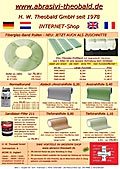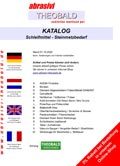Home About brushes Origins
Origins
The "aging" of natural stone arose from the desire of copying the look of old coverings, which show a certain charm and a Mediterranean atmosphere in spite of its defective appearance. Defects such as open wires, soft and washed-out points, edge damage and uneven surfaces made a pleasant contrast to new sterile, smooth and polished surfaces. At the beginning of this trend there was a quest for something new - however provided with a patina as evidence of a noble old arising in centuries. This aging method found an application on soft stone such as Botticino and Rosso Verona or varieties of Asiago from the same area. As a result there was an uneven surface, unopposed over many years. The new antique look is robust. It is partially sealed with wax to underline the "used-look". It has become a hit without any doubt.
The soft materials - limestone, marble and so on - could be produced with SIC brushes for this antiquisation, but rather a vast number of hard stones were at the same time represent the market. Trying to work on the surface of hard stone by the same treatment, you had to admit that the SIC brushes were not able to do so. They were ineffective. The hard stones had to be prepared first by flaming, sandblasting, plate blasting, etc. to achieve a "bumpy" surface. Thereafter, thus roughened surface was further treated with SIC brushes, helping to bring out the surface version "flamed-brushed".
In consequence of this development, the diamond grit came up instead of the previous SIC grit. Only the diamond brushes were able to process on the even surfaces of hard stone so that now emerged new types of surfaces, which are today represented so as "glazing", "Leather Touch", "Velvet" in the market. Besides the use of DIA-brushes on flat-smooth surfaces these are now being used on previously roughened surfaces and achieve in a much shorter time a larger high-low effect.
Surfaces such as SATIN - LEATHER TOUCH - VELVET are:
- slightly profiled surface of soft and hard rock,
- without the the need to roughen the surface beforehand by flaming, sandblasting, etc.
Our DIAMOND brushes act more on the softer parts of the mineral natural stones than on the hard constituents. The result is a completely individual characteristic of the surface - different, depending on the material. A "fine-grained" material like "Nero Assoluto" or "Impala" is uniform after processing the structure. A material with tiled texture retains its irregular, cloudy or striped texture even after brushing. Longer duration or starting with a coarser brush decides about the result of a deeper or shallower profile. In general, the coarser the grain of the first brush of the grit sequence or the longer the exposure time of the brush (NOT the pressure !!!), the more pronounced and deeper is the resulting relief.
The final product can be
- antique (deep profiled = Antik)
- satin (slightly profiled = satin) or
- velvet (low profiled = Velvet).
Use the following grit sequences:
For glazing: 30/40 - 60/80 - 120/140 - 170/200
For aging use the same grit sequence, burt using 30/40 longer. Alternatively, you can use grain 40/50.
To achieve Leather-Toch on composite stone, use 60/80 - 120/140 - 170/200.
Comment:
You will find that on engineered stone a coarser brush 30/40 or a very long exposure time has no effect on the final appearance of the surface structure. Brushing up to grain 170/200 gives a matte finish. Through the subsequent use of other, finer grits you can come to any surface to polishing.
Achieving a surface R9 or R10 is possible on any type of material and also to maintain after installation at any time on the same Rutschhemmfaktor by refreshed locally with the same brushing grit.







